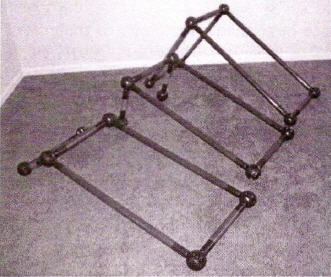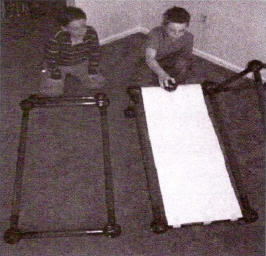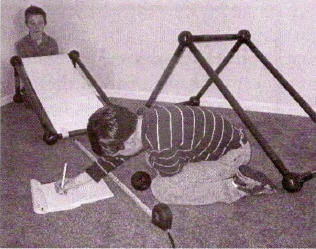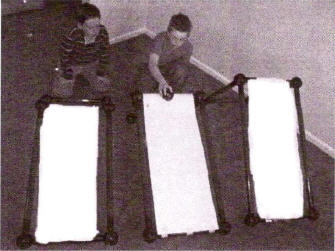Students will construct ramps of different heights and measure the distance traveled from the top of the ramps by Toobeez spheres to understand potential and kinetic energy.
Setup Time: 20 – 25 minutes
Materials
Time: 50 – 60 minutes
Instruction: Whole class and small groups
Space: Lots

1. Divide the class into three teams. Each team should build a rectangular frame consisting of:
2. Each team should build a ramp of equal length but varying heights using the rectangular frames with different lengths of Toobeez as support pieces.

The models are examples of the teams’ ramps. From left to right, Team 3, Team 2 and Team I are pictured.
Teacher Note: Tubes for the varying heights will not always be perfectly perpendicular to the floor.
3. Have each team securely attach butcher paper to the top cross piece of each ramp with masking tape and run the paper down the length of the ramp to the other cross piece.
4. Attach the bottom of the butcher paper securely to the floor, not to the bottom cross piece. Make sure the butcher paper is tight and forms a smooth surface from the top to the floor.
Helpful Hints
1. Provide each team with one copy of the Measurement Recording Sheet or have them create one of their own.
2. Read aloud the following Activity Challenge Box to the group.
Challenge: Students will construct ramps of different heights and measure the distance traveled from the top of the ramps by Toobeez spheres to understand potential and kinetic energy.
 4. Using the meter stick or measuring tape, have another team member measure the distance the sphere rolled. A third team member should record the result on their Measurement Recording Sheet.
4. Using the meter stick or measuring tape, have another team member measure the distance the sphere rolled. A third team member should record the result on their Measurement Recording Sheet. 5. Once each team has completed four roll sand recorded their results, have them determine the average distance rolled by the spheres on each ramp.
5. Once each team has completed four roll sand recorded their results, have them determine the average distance rolled by the spheres on each ramp.7. After the activity, circle up the group and ask them the following question:”How did the height of the ramp affect the amount of potential energy in each sphere?”
8. Finally, move to the “Activity Discussion and Processing” section of the activity.
To close the lesson, end with a group discussion about what was learned during the activity. Circle up the group and work through the following questions. If possible, record the group’s responses on flip chart paper so all comments are displayed.
1. Reproducing results.
Provide each team with a new Measurement Recording Sheet and assign each team a different ramp and conduct the activity again. Discuss the importance of reproducing results in scientific experiments.
2. Extension/Follow up.
Have students experiment with constructing ramps with other lengths and heights. Instruct them to speculate what the results might be before conducting the experiments.
